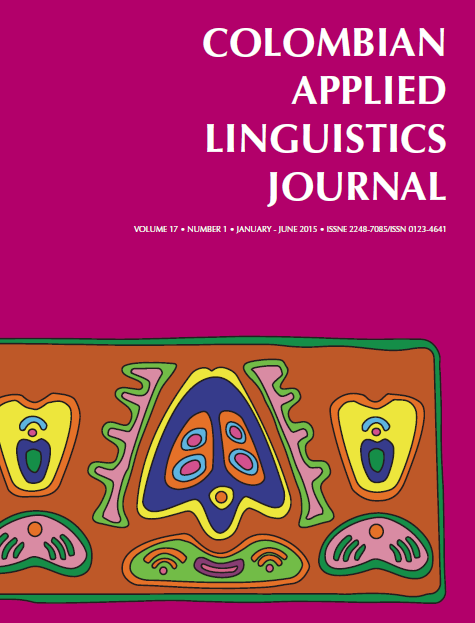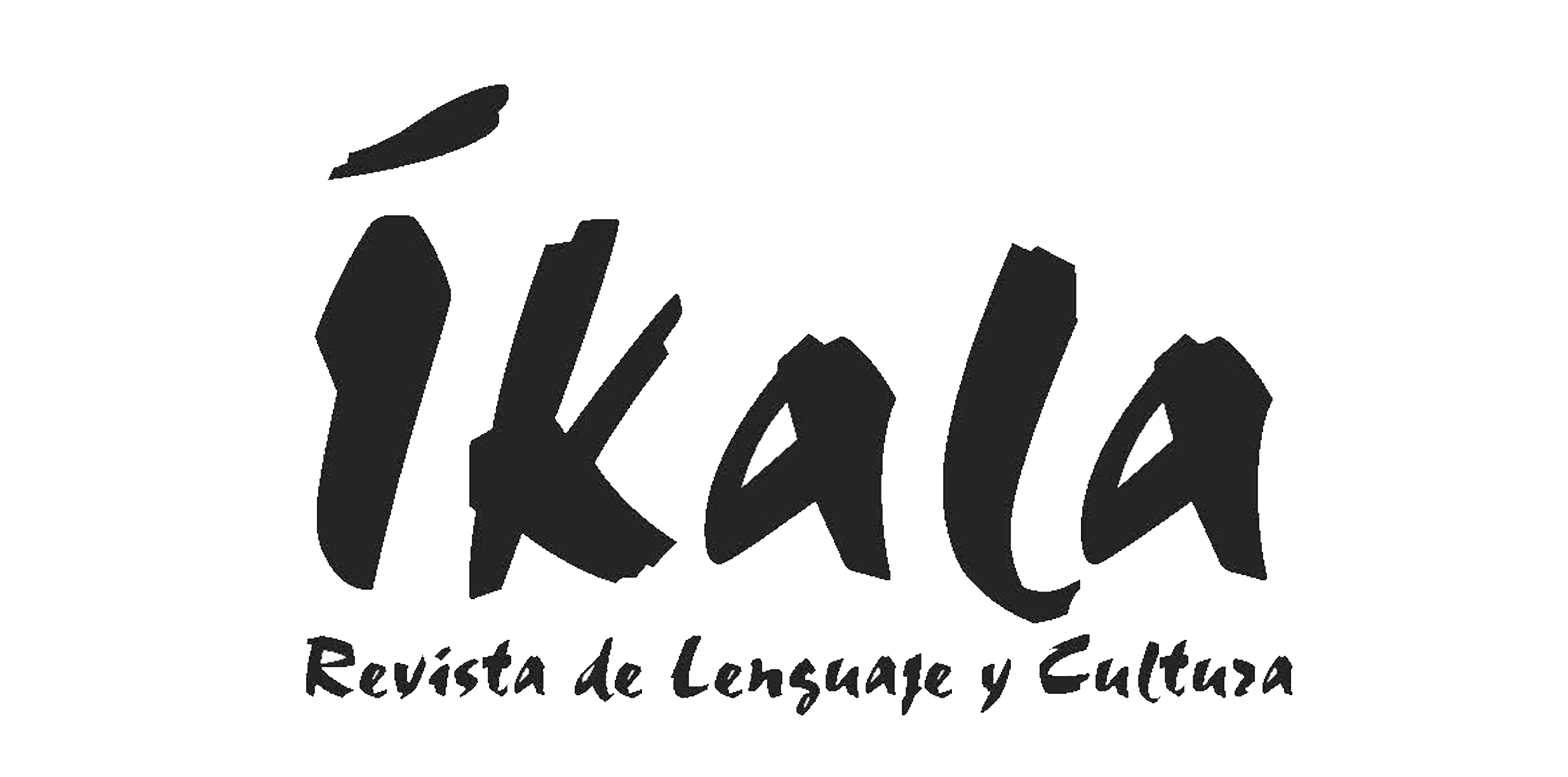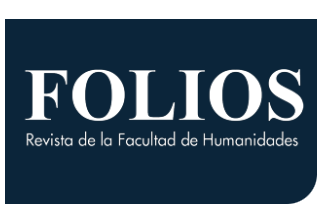DOI:
https://doi.org/10.14483/udistrital.jour.calj.2015.1.a09Published:
2015-05-06Issue:
Vol 17, No 1 (2015) January-JuneSection:
Reflections on PraxisThe design process of a reading comprehension manual
El proceso de diseño de un manual de comprensión de lectura
Keywords:
lengua extranjera (LE), diseño de material, lectura (es).Keywords:
FL reading, material design, professional development (en).Abstract (en)
Material design is an important part in the teaching practices. This article describes the process of material design of a foreign language (FL) reading manual for undergraduate students at Universidad de Antioquia (Medellín, Colombia). Action research was used as methodological guide to design the manual. Four in-service English teachers participated in the process of the design and they took into account issues such as the program of reading comprehension I, readings that contain cultural information and active background knowledge, reading with visual aids, and exercises that involved pre-, while-, and post-reading activities. As a result, a sample of a reading strategy is given in order to illustrate how teachers worked and designed the manual. Conclusions suggest that the process of designing a manual helped teachers understand their beliefs and practice in teaching reading in a foreign language.
Abstract (es)
El diseño de material es una parte importante en las prácticas de enseñanza. Este artículo describe el proceso de diseño de material de un manual de lectura en lengua extranjera (LE) para los estudiantes de pregrado de la Universidad de Antioquia (Medellín, Colombia). La investigación-acción se utilizó como guía metodológica para el diseño del manual. Cuatro profesores de inglés participaron en el diseño del manual y tuvieron en cuenta elementos tales como el programa de comprensión de lectura I, lecturas que contuvieran información cultural y que activaran el conocimiento previo, lecturas con ayudas visuales y ejercicios que involucraran actividades de pre, mientras y post lectura. Como resultado se brinda una muestra de estrategia de lectura que ilustra como los profesores trabajaron y diseñaron el material. Las conclusiones sugieren que el proceso de diseño de este manual ayudó a los profesores a entender sus creencias y prácticas en enseñanza de lectura como lengua extranjera.
References
Abromitis, B. (1994). The role of metacognition in reading comprehension: Iimplications for instruction. Literacy Research Report, 19, 1-31.
Alyousef, H. (2005). Teaching reading comprehension to ESL/EFL learners. The Reading Matrix, 5(2), 143-154.
Areiza, H. (2013). Role of systematic formative assessment on students’ views of their learning. PROFILE, 15(2), 165-183.
Arias, C., & Maturana L. (2005). Evaluación en lenguas extranjeras: Discursos y prácticas. Ikala, Revista de Lenguaje y Cultura, 16, 63-94.
Aebersold, J., & Lee Field, M. (1997). From reader to reading teacher. Cambridge: Cambridge University Press.
Block, E. (1986). The comprehension strategies of second language readers. TESOL Quarterly, 20(3), 63-490.
Brown, D. (2001). Teaching by principles. United States: New York: Longman.
Burns, A. (1999). Collaborative action research for English language teachers. London: Cambridge University Press.
Carrell, P., Pharis, B., & Liberto, J. (1989). Metacognitive strategy training for ESL reading. TESOL Quarterly, 23, 647–678.
Carrell, P. (1984). Schema theory and ESL reading classroom implications and applications. Modern Language Journal, 68(4), 332-342.
Correia, R. (2006). Encouraging critical reading in the EFL classroom. English Teaching Forum, 1, 16-19.
Davis, J. N., & Bistodeau, L. (1993). How do L1 and L2 reading differ? Evidence from think aloud protocols. The Modern Language Journal, 77(4), 459-471.
Day, R., & Bamford, J. (2000). Extensive reading in the second language classroom. Cambridge: Cambridge University Press
Dubin, F., & Bycina, D. (1991). Academic reading and the EFL/ESL teacher. In M. Celce-Murcia (Ed.), Teaching English as a second or foreign language (pp.195-215). New York: Heinle & Meinle publishers.
Grabe, W., & Stoller, F. (2002). Teaching and researching reading. England: Pearson Education.
Harwood, N. (2010). Materials in ELT: Theory and practice. Cambridge: Cambridge University Press.
Howard, J., & Major, J. (2004). Guidelines for designing effective English language teaching materials. The TESOLANZ Journal, 12, 50-58.
Janzen, J. (2005). Teaching strategic reading. In J. Richards & A. R. Will (Eds.), Methodology in language teaching. An anthology of written practice (pp. 287-295). Cambridge: Cambridge University Press
Kuzborska, I. (2011). Teachers’ decision-making processes when designing EAP reading materials in a Lithuanian university setting. Journal of English for Academic Purposes, 223-237.
Lopera, S. (2012). Effects of strategy instruction in an EFL reading comprehension course: a case study. PROFILE, 14(1), 79-90.
Lopera, S. (2014). Motivation conditions in a foreign language reading comprehension course offering both a web-based modality and a face-to-face modality. PROFILE, 16(1), 89-104.
McDonough, J., & Shaw, C. (1993). Materials and methods in ELT. Oxford: Blackwell.
Mertler, C. A. (2009). Action research (second edition). Los Angeles, London, New Delhi: SAGE Publications.
Mikulecky, B., & Jeffries, L. (2004). Reading power. United States: Pearson, Longman.
Nunan, D. (1999). Second language teaching and learning. Boston: Heinle & Heinle Publishers.
Núñez, A., & Téllez, M. (2009). ELT materials: The key to fostering effective teaching and learning settings. PROFILE, 11(2), 171-186.
Núñez, A., & Téllez, M. (2008). Meeting students’ needs. Enletawa Journal, 1, 65-68.
Omaggio, A. (1993). Teaching language in context. Boston: Heinle & Heinle Publishers.
Oxford, R. (2002). Sources of variation in language learning. In R. B. Kaplan (Ed.), The Oxford handbook of applied linguistics (pp. 245-252). New York: Oxford University Press.
Picón, E. (2012). Promoting learner autonomy through teacher-student partnership assessment in an American high-school: a cycle of action research. PROFILE, 14(2), 145-162.
Richards, J. (2005). Interchange (3rd ed.). Cambridge: Cambridge University Press.
Richards, J., & Eckstut-Didier, S. (2003). Strategic reading. Cambridge: Cambridge University Press.
Royer, J. (2004). Teaching reading comprehension skills. Retrieved from http://educator.readingsuccesslab.com/Tips/TeachingReadingComprehensionSkills.html
Selener, D. (1997). Participatory action research and social change. New York, NY: The Cornell Participatory Action Research Network.
Smith, L., & Mare, N. (1999). Insights for today. Boston: Heinle & Heinle Publishers.
Tomal, D. (2010). Action research for educators (2nd edition). Lanham MD: Rowman & Littlefield Education.
Tomlinson, B. (1998). Materials development in language teaching. Cambridge: Cambridge University Press.
Tomlinson, B. (2012). Materials development for language learning and teaching. Language Teaching, 45(2), 143-179.
Ur, P. (1999). A course in language teaching. Cambridge: Cambridge University Press.
Villanueva de Debat, E. (2006). Applying current approaches to the teaching of reading. English Teaching Forum, 1, 2006.
Werner, P., & Spaventa, L. (2002). Mosaic 1, Grammar. New York: McGraw-Hill.
Williams, R. (1986). “Top ten” principles for teaching reading. ELT Journal, 40 (1), 42-45.
How to Cite
APA
ACM
ACS
ABNT
Chicago
Harvard
IEEE
MLA
Turabian
Vancouver
Download Citation
Metrics
License
This work is licensed under a Creative Commons Attribution-NonCommercial-NoDerivatives 4.0 International License.
Attribution — You must give appropriate credit, provide a link to the license, and indicate if changes were made. You may do so in any reasonable manner, but not in any way that suggests the licensor endorses you or your use.
NonCommercial — You may not use the material for commercial purposes.
NoDerivatives — If you remix, transform, or build upon the material, you may not distribute the modified material.
The journal allow the author(s) to hold the copyright without restrictions. Also, The Colombian Apllied Linguistics Journal will allow the author(s) to retain publishing rights without restrictions.









